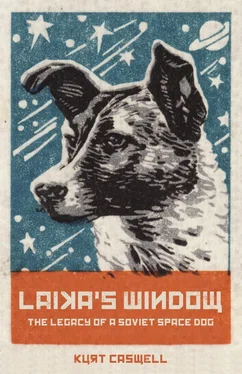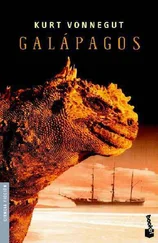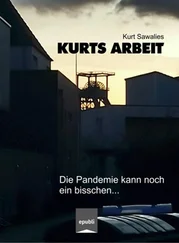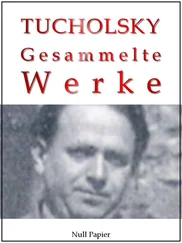¤
When Laika came to the kennels in Korolev’s space dog program, the team of engineers and scientists first knew her as Kudryavka, Russian for Curly, or Little Curly. A few sources report a nickname, Zhuchka, or Little Bug. After she went into space, a few Soviet sources referred to her as Limonchik, or Little Lemon, but that name fell away rather quickly. Then, capitalizing on the name of the satellite itself, the American press came to call her Mutnik, a mongrel satellite. But the name by which she is best known, her true and proper name, is Laika, the first living being to orbit the Earth, and the first to die out there too. Laika is a noun derived from the Russian verb layat , which means to bark. So in Russian, Laika means Barker, or Little Barker. The word laika also refers to a breed of dog, a medium-sized hunting dog of northern Siberia, of which there are several types. Laika herself may have come from laika stock, but it would be incorrect to call her a laika. She was a mixed breed, a mongrel, a throwaway of unknown origin, living off the scraps and refuse of Muscovites.
That Laika barked, or was a barker, is not in question, but what did her barking mean to the Soviet team that trained and worked with her? Is her name an expression of their annoyance or impatience with her and her barking? Or is it a celebration of her personality, her character, an identifier as a vocal dog, a dog that speaks, a dog that communicates because she is in tune with her surroundings and the dogs and people who interact with her? Perhaps the team came to regard Laika’s barking as a quality that distinguished her from the other space dogs in the kennels, a characteristic that made her stand out.
At the time of her flight, Laika weighed thirteen pounds and was about two years old, the ideal size and age for a space dog. Her fur was mostly white, with a darker brown covering her face, and a circle of white running around her black nose and leading up between her eyes to the crown of her head. Her ears stood straight up, like a lot of laika breed dogs, but then bent over at the tips, giving her a friendly look. In video footage of Laika, her bent ears bounce about as she sits or stands, panting, giving her an air of nervous ease. In her eyes, though, is an attendant intelligence, a quiet confidence, the look of a dog that is deeply attuned to the people around her, to what they are doing, and what that means to what she is doing.
A memorial sculpture in Moscow depicts Laika with her tail curled up over her back, another common trait among laika breeds, and this curly tail might be the reason for initially calling her Little Curly. But in most of the photographs of Laika I have seen, her tail hangs straight down like a German shepherd. In these photographs, though, Laika is wearing her flight suit and harness with its waste collection bag. In Inside of a Dog , Alexandra Horowitz writes that dressing a dog in clothing (a sweater or a raincoat, for example) reproduces the feeling of another dog standing over it, pressing down on it in a show of dominance. Perhaps Laika’s posture in these photographs, then—standing frozen in place, her tail dropped straight down—registers discomfort and submission. Presumably when she was free and running about, or out on a walk with her handlers, her tail rolled up into that nice little curl.
Laika’s story comes into the historical and cultural record when she becomes a space dog in training. As a stray living on the streets of Moscow, she was acquired by physician Vladimir Yazdovsky’s team, the man Korolev had put in charge of directing biomedical operations in the emerging space program, which included training and caring for the space dogs. If Laika had been on some other Moscow street that day, or hidden away in a quiet alley, or had she simply lived in some other part of the city, she would have been just another stray, faceless, nameless, living and dying in her time. Her story would have been so unremarkable as to be lost to us, as are the stories of most of the living creatures, humans included, across the ages of the Earth.
While we cannot know much about Laika’s life before she came to Korolev’s kennels, we can imagine it. In his graphic novel Laika , Nick Abadzis does imagine it, and it allows us a window on the early life of the dog that took us to the stars.
In Abadzis’s book, Laika is born into a litter of seven puppies in the house of a government official. The housemaid is ordered to get rid of the pups. One of the female pups becomes her darling, and the housemaid works hard to find her a proper home. A family adopts the pup for their young son. The boy resents the little dog for the way she demands his attention and time, and one night he tosses her into the Moscow River. She swims to the bank, a castoff, and takes to the streets. She befriends another stray dog. When a team of city dogcatchers captures her, they kill her companion in the process. A sympathetic dogcatcher peers in at the pup through the door of her cage and remarks that she “looks like [she’s] been through the wars.” The animal shelter is full, and the pup will have to be euthanized, but then the dogcatcher remembers Yazdovsky, “the air force chap,” who is looking for small stray dogs for some secret government program. That secret government program is, of course, the space program, the program developing missiles and rockets, and training dogs to ride those rockets into space. And so the pup becomes a space dog. The pup becomes Laika.
In Abadzis’s book, the housemaid keeps Laika in her heart and thoughts, even after she is gone, and Laika too bears a memory of the housemaid. Neither knows where the other is, but their bond remains strong, for it is the bond that tethers those who go with those who stay behind. “Never look back,” Abadzis writes as Laika roams the Moscow streets. “Although those you leave behind will still think of you. We do still think of you.”
I have to wonder, when Laika was a street dog in Moscow, did someone feed her, help her, give her a warm place to sleep on a cold winter night? Did a kind restaurateur give her food scraps when she appeared at the alley door? Was that someone a man, a woman, or several men or women? Was Laika befriended by a child? Did these people I am imagining mark that day when Laika, who was always there, was suddenly gone? And living through those next decades, and to the end of their lives, did they know (how could they know?) that the stray dog from the streets they had become so fond of was the same dog they read about in the newspapers and heard about on the radio, the now world-famous dog orbiting the Earth?
Despite the possibility of such a guardian angel attending to Laika on the streets, life inside Korolev’s kennels would have been a marked improvement. Of course, she had to endure space dog training, and eventually the job she was trained to do, but in exchange, she lived in a warm, dry enclosure with wooden floors, with clean bedding of wood shavings or straw. She had the company and social interaction of other space dogs in training, most with similar backgrounds and stories. Her handlers took her out for a walk at least twice a day. And she was watered and fed regularly, a diet that included meat, bone broth, vegetables, fish oil, and milk. Space dogs that were about to fly in a rocket were offered an even better meal that sometimes included a good Russian sausage. This practice was carried forward to cosmonauts and astronauts, who gather even today for a preflight meal and may request anything they desire from the kitchen.
¤
When Sputnik II went up, the Soviet Union had already beaten the United States into orbit with Sputnik I , the world’s first artificial satellite, establishing the Soviets’ technological superiority, and so their supposed superiority as a people and a nation. “Success in space,” writes James Oberg in Red Star Rising , “implied superiority on earth.” This feat is even more astonishing considering the ruinous state of the USSR at the end of World War II. “No other nation in the world was as devastated and crippled by the war,” writes Fordham University space historian Asif Siddiqi in Challenge to Apollo . The war killed some twenty-seven million Russian soldiers and citizens and destroyed some 1,700 cities along with half the nation’s housing. The agricultural system “was close to famine proportions.” Astonishing that out of this kind of ruin, it took the USSR just over a decade to put Sputnik I into orbit. But however astonishing the sight of that satellite in orbit, it was tempered in those days by an equally awesome terror rising out of this new technology, a technology that enabled one nation to destroy another with the touch of a button. As the world’s first intercontinental ballistic missile (ICBM), the rocket that carried Sputnik into orbit could also carry a nuclear warhead to nearly any place on Earth.
Читать дальше












